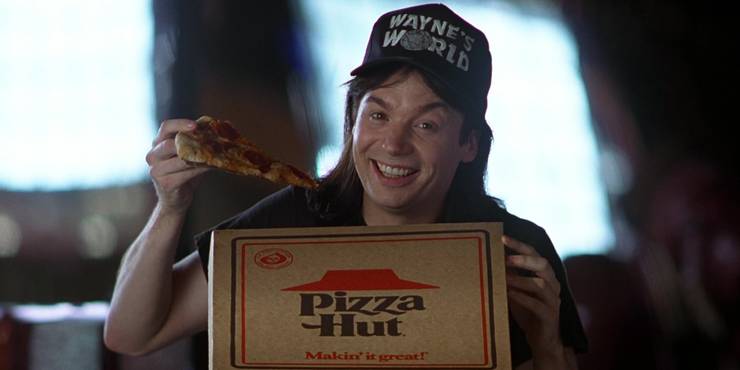Adaptation & 9 Other Delightfully Self-Aware Movies

Most movies want the audience to forget they’re watching a movie. The magic trick of cinema is to tell a story that’s so immersive that the viewer is taken beyond the artifice of film and connects with the characters like they’re real people. But a handful of movies go the other way, like Deadpool, constantly reminding audiences that they’re watching a movie with a make-believe story and actors playing dress-up.
Self-aware movies don’t have to be comedies. Self-awareness can be used for any number of artistic reasons. In Adaptation, the meta-ness is there to break down how movies are constructed and whether following the established rules of storytelling is a good thing.
10 Adaptation (2002)

When Charlie Kaufman was hired to adapt The Orchid Thief into a movie, he struggled with the adaptation process and instead wrote a movie called Adaptation about a screenwriter named Charlie Kaufman (living with his fictional twin brother Donald) struggling to turn Susan Orlean’s book into a workable script.
The movie is intercut with an actual adaptation of The Orchid Thief, with Meryl Streep playing Orlean herself, but it’s mostly an indictment of the kind of formulaic screenwriting encouraged by the Hollywood machine.
9 21 Jump Street (2012)

Phil Lord and Christopher Miller’s reboot of 21 Jump Street is fully aware that a lot of modern audiences aren’t familiar with the old TV series and don’t care about its new movie adaptation, and uses that to poke fun at Hollywood’s incessant rehashing of existing intellectual properties.
This is especially prevalent in any scene with Nick Offerman as Deputy Chief Hardy, who delivers blunt self-aware jabs to the franchise with his usual deadpan wit.
8 Kiss Kiss Bang Bang (2005)

Shane Black’s ultra-meta neo-noir Kiss Kiss Bang Bang is carried by a voiceover narration by Robert Downey Jr. that constantly addresses the audience: “I don’t see another g**damn narrator, so pipe down,” “Don’t worry, I saw Lord of the Rings, I’m not going to end this 17 times.”
Downey plays a small-time criminal who stumbles into an acting career in L.A., then stumbles into the latest grisly case being tackled by private eye Gay Perry, played by Val Kilmer.
7 Deadpool (2016)

After the disappointment of X-Men Origins: Wolverine, Deadpool finally got a faithful movie adaptation in 2016 and Ryan Reynolds knocked it out of the park. With a hard-R rating, Deadpool was free to capture its title character’s every NSFW eccentricity.
This includes his constant fourth wall breaks. In the comics, ‘Pool breaks the fourth wall to deconstruct the comic book medium. In the movie, Reynolds brilliantly translates it to a self-aware superhero blockbuster that stands out in a saturated market because it takes satirical jabs at that very market.
6 Blazing Saddles (1974)

Almost all of Mel Brooks’ movies break the fourth wall (although Gene Wilder forbade Brooks from doing so in Young Frankenstein), but none of them do it as masterfully as Blazing Saddles. The movie’s deconstruction of the western myths comes to a head when the climactic battle moves out of the western town set and onto the set of a musical, then into the studio cafeteria, then out onto the streets of Los Angeles.
The final showdown between the hero and villain takes place outside Grauman’s Chinese Theater, where Sheriff Bart and the Waco Kid then watch the rest of the movie. The artifice is as clear as day as they watch themselves ride off into the sunset, then get off their horses and are driven away in cars.
5 Wayne’s World (1992)

The most obvious example of self-awareness in Wayne’s World is Wayne’s disregard for the fourth wall — often talking to the audience and occasionally even talking to the camera operator — but the whole movie is a meta goldmine.
The absurd amount of product placement in a scene in which Wayne and Garth vow not to sell out to corporate sponsors is one of the most memorable self-aware bits in the movie.
4 Birdman (2014)

Alejandro G. Iñárritu’s Best Picture-winning surrealist pitch-black comedy Birdman is edited to look like it was shot in a single take, following the chaotic life of Riggan Thomson, a washed-up superhero movie star desperate to prove himself as an artist and not just a Trivial Pursuit answer with a Broadway play adapted from Raymond Carver.
There’s a self-aware irony in the casting of ex-Batman Michael Keaton in the lead role. Ironically, Birdman proved Keaton’s own prowess as a dramatic actor and scored him a Best Actor nomination.
3 Scream (1996)

After helming one of the early classics that pioneered the slasher genre, A Nightmare on Elm Street, Wes Craven ripped that same genre to shreds with his satirical mid-‘90s gem Scream.
The movie starts with the familiar setup of a masked killer targeting high schoolers, but the twist is that these high schoolers have seen all the horror movies that have this exact same premise.
2 Monty Python And The Holy Grail (1975)

The Pythons’ first movie made from entirely original material, Monty Python and the Holy Grail, remains one of the freshest comedies of all time nearly half a century after its initial release. In addition to breaking down the Arthurian legend, the movie breaks down the medium of film itself.
From the characters in other scenes waiting for their moment in the spotlight saying, “Get on with it!” to the hilariously anticlimactic final scene, Monty Python and the Holy Grail is a meta masterpiece.
1 8½ (1963)

After helming such timeless masterpieces as La Dolce Vita and I Vitelloni, Federico Fellini suffered from a creative block that he cured by making 8½, a movie about a filmmaker who suffers from his own creative block.
A lot of Fellini’s films are self-reflexive, but this one is the most overt about it. It cuts between lyrical dream sequences and sobering reality.
About The Author

















